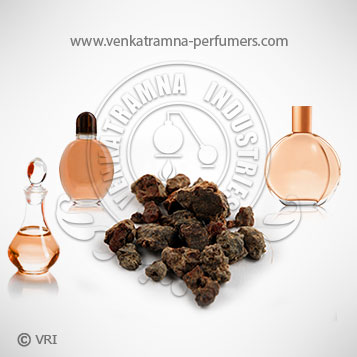
| Botanical Name | Commiphora myrrha |
| Common Name | Myrrh oil |
| Country of Origin | Yemen, Somalia |
| Solubility | N/A |
| Specific Gravity | 998 |
| Optical Rotation | -88,50 |
| Refrective Index | NA |
| PlantPart | Resin |
| Bland With | Alcohol, Acetophenone, Algae absolute, Allspice oil, Amber carbinol |
| CAS No | 8016-37-3 |
| Flash Point | 89°C |
| Extraction Method | Solvent extracted |
Myrrh absolute is a finer strong odor based liquid used as excellent skincare and body care constituent. Lighter in colour when compared with resinoid, it helps in fining cure for bronchitis, dysmenorrhea, chapped skin, gums, hemorrhoids, halitosis, itching and others. Myrrh absolute is largely used in oral hygiene products.
Myrrh embodies hardship and pain. Growing in the most desolate of places near the Red Sea, it bears its resinous tears from wounds of sorrow. The myth of Myrrha is a sad story of incest and guilt. Being in love with her father, King Cynyras of Cyprus, the poor girl, seduced him while her mother and all married women were away during the festival of Ceres. On the third, night the king, curious who his lover was, shone a light in her face. Shocked and reviled he grabbed for the sword to kill her but she ran away. Pregnant and unhappy to the core of her soul she wandered the earth for the term of her pregnancy. But before she gave birth she prayed to the Gods to turn her into a tree so she would neither offend the living nor the dead. Her wish was granted and she was transformed into a Myrrh tree. Her tears of sorrow and regret still keep flowing. Despite this sad story Myrrh was highly revered as incense and medicine throughout the ancient world. It is always mentioned for its power to bring on menstruation and expel old blood and the fruit of the womb, so perhaps this myth is a veiled hint regarding the use of Myrrh to expel the fruit of immoral unions. In Egypt, Myrrh was associated with the cult of the dead, being an important ingredient of the embalming mixture. It was also used as a sacrificial offering to the Gods. In ancient Egypt it was included in Kyphi incense and in the embalming lotion. Both, in ancient and modern times Myrrh plays a role in healing and beauty preparations.
Color : Woody, balsamic & earthy,
Aroma : Warm, rich, spicy balsamic odor.
Main Constituents of the oil are a-pinene, Cadinene, Limonene, Cuminaldehyde, Eugenol m-cresol, Heerabolene, Acetic acid, Formic acid, Other sesquiterpenes & acids
Amenorrhea, Athlete's foot, Bronchitis, Chapped skin, Dysmenorrhea, Gums, Halitosis, Hemorrhoids, Itching, Ringworm, Toothache